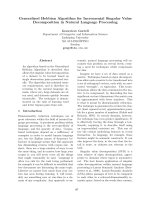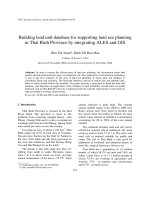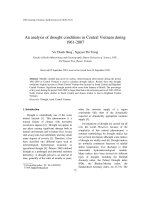Báo cáo " An analysis of soil characteristics for agricultural land use orientation in Thai Thuy District, Thai Binh " pdf
Bạn đang xem bản rút gọn của tài liệu. Xem và tải ngay bản đầy đủ của tài liệu tại đây (170.84 KB, 5 trang )
VNU Journal of Science, Earth Sciences 23 (2007) 105-109
105
An analysis of soil characteristics for agricultural land use
orientation in Thai Thuy District, Thai Binh Province
Pham Quang Tuan*
College of Science, VNU
Received 03 March 2007
Abstract. This paper presents the results of soil characteristics study and orientation for rational
and sustainable use of major soil types in Thai Thuy District, Thai Binh Province, where is facing
many environmental problems. The interactive process between river, sea and human activities
over time has resulted in the characteristics of 10 soil types, which are grouped in 4 main classes
(acid sulfate soil, saline soil, alluvial soil and sandy soil). They have been used for agricultural
production (mainly for rice and other crops growing). Initial analysis of soil environment quality
has shown that soil environment has been polluted due to residual content of pesticides such as
Padan and Fen kept in agricultural land.
On basis of the analysis of characteristics and environment of the main soil classes, the paper
has made some recommendations to ensure their sustainable use.
Keywords: Soil characteristics; Sustainable agricultural land use; Thai Thuy District.
1. Introduction
*
Thai Thuy is a rural district situated in Thai
Binh Province’s coastal zone, where there is
diversification in natural conditions, natural
resources and land use orientation due to the
interactions between marine-mainland factor
and human activities.
The total area Thai Thuy district is 297.4
km
2
(including tidal flat area); agricultural land
accounts for 64%, and 87% of which (or 56% of
the total area) is for paddy rice and other
vegetation. It means that agriculture, especially
paddy and vegetation crops, is the major
economic activity in the district.
Land resources play an important role for
_______
*
Tel.: 84-4-8581420.
E-mail:
agricultural economy. Therefore, the rational
use of land resources is necessary in order to
aim at the sustainable development purpose in
the process of rural modernization and
industrialization.
2. Materials and research methods
The article uses data gathered from the soil
profiles during the field survey. The results of
soil samples are then analysed in the Soil
Laboratory of Hanoi Agriculture University No
I. The following indicators are chosen: pHKCl,
H
+
, Al
3+
, OM, CEC, NO2, P2O5, K2O, Cl
-
and SO4
2-
and residual vegetation protection chemical such
as Pandan, Fenvalerate (Fen), Dimethoat (Dim),
Trichlorfon and Fenitrothion (Tri).
Pham Quang Tuan / VNU Journal of Science, Earth Sciences 23 (2007) 105-109
106
The research methods were applied in the
study such as desk study, field survey and soil
sample analysis.
3. Soil characteristics
Interactive process between basic solid
materials, nutritive source from bed rocks, with
local meteorological characteristics and human
activities have established the soil crust. Land
suitability for paddy and vegetation crops was
evaluated based on the distribution of soil in
the study area [1, 2]. The soil characteristics can
be derived from soil samples analysis and the
results of field surveys (focusing on three
important parameters as physical, chemical
characteristics and residual of pesticide).
According to the soil classification system,
which based on genesis principle, there are four
main soil classes including 10 soil types in Thai
Thuy District, as follows:
- Acid sulfate soil class including 2 soil
types: latent acid sulfate soil (S
p
) and active acid
sulfate soil (S
J
).
- Saline soil class including 4 soil types: low
saline soil (Mi), medium saline soil (M), high
saline soil (Mn) and saline soil with aegiceras
(M
s
).
- Alluvial soil class including 2 soil types:
annually deposited alluvial soil (P
b
) and non-
deposited alluvial soil (P
k
).
- Sandy soil class including 2 soil types:
white sandy dune soil (C
c
) and marine sandy
soil (C).
3.1. Characteristics of acid sulfate soil class
Acid sulfate soil usually contains iron or
alumni. When hydrolyzes, it creates sulfuric
acid, which made soil sour. Occurrence of
Fe(OH)
3
fashioned sublimes iron rust. The
sulfur content in acid sulfate soil is directly
proportional to SO
4
2-
in vegetation and sulfur
content in total. Al
3+
component is richer in
active acid sulfate soil than in latent acid sulfate
soil. When pH is less than 4, SO
4
2-
is more
dominant than Cl
-
in component of acid sulfate
soils [3].
In Thai Thuy District, acid sulfate soil class
is very important and occupies a large area in
the northern of Diem Ho River. It is located
mostly in Thuy Thanh, Thuy Duyen, Thuy An,
Thuy Chinh, Thuy Dan, Thuy Ninh, Thuy Van,
Thuy Binh, Thuy Quynh and Thuy Huong
communes, which are inside the dyke. Acid
sulfate soil has medium mechanic content. The
local people uses acid sulfate soil for farming
(mainly are paddy composition and vegetation
culture). The remaining of the mangrove forest is
still well conserved. The results are shown in
Table 1.
Analytical result has shown that active and
latent acid sulfate soils react with very sour soil,
pHKCl in cultivated soil layer fluctuates from 3.7
to 4.2. When pH
KCl
is less than 4 in soil
environment, the content of Cl
-
is higher than
that of SO
4
2-
, fluctuating from 0.071% to 0.19%
and content difference of Cl
-
and SO
4
2-
is not
considerable (from 1.062% to 1.081%). In the
soil environment, roving Al
3+
occurs with low
content (from 0.22 to 0.29ldl / 100g soil) and is
not toxic for vegetation. Humus content in the
top soil layer is from average to good degree
(2.7% to 3.8%) with absorbing potential less
than 10ldl / 100g soil. The absorbing potentials
in water logged rice field reach 10ldl / 100g soil.
NPK nutritive content in total and digestible
nutritive content are medium degree, Kali
content in total is rich and digestible, phosphate
content is low (less than 10mg / 100g soil).
3.2. Saline soil class
Saline soil class was formed by river and
marine sediment, which deposited in saline
environment. Saline soil class distributed in
coastal communes and the proximity of the
three big rivers flowing through Thai Thuy
District when tidal level is penetrating along
Pham Quang Tuan / VNU Journal of Science, Earth Sciences 23 (2007) 105-109
107
Table 1: The results soil samples analysis in Thai Thuy District, Thai Binh Province
pH
H2O
pH
KCl
Al
3+
H
Tp
CEC OM N P
2
O
5
K
2
O
P
2
O
5
K
2
O Cl
-
SO
4
2-
PADan
Fen
DIM
TRI
No.
Symbol
Soil type
Land use
ldl / 100g soil % Mg / 100g soil
% Mg / Kg
1 TT1 S Paddy land (2 crops) 4,52 3,90 0,22
6,60
10,20
3,80
0,18
0,100
1,45
9,40 13,80 0,062
0,063
2 TT5 S Paddy land (2 crops) 4,65 3,90 0,29
6,50
9,70 2,90
0,17
0,100
1,49
8,50 14,90 0,073
0,071
0,09 0,07
0,01
0,01
3 TT3 S
n
Bare land 4,30 3,80 0,24
6,40
9,90 3,10
0,08
0,110
1,74
8,70 15,20 0,120
0,190
4 TT6 S
n
Paddy rice - vegetable
4,69 3,70 0,23
6,40
8,50 2,70
0,13
0,130
1,20
9,20 11,30 0,085
0,081
0,12 0,08
0,01
0,01
5 TT4 M
i
Paddy land 6,05 6,20 0,00
4,50
10,50
2,98
0,21
0,090
2,37
16,00 17,80 0,039
6 TT2 M
i
Paddy land 5,78 6,50 0,00
4,70
9,30 2,20
0,14
0,085
2,14
15,20 15,50 0,042
0,08 0,05
0,01
0,02
7 TT10 M Paddy land 5,90 5,70 0,00
9,80 2,70
0,15
0,071
2,02
15,80 14,70 0,063
8 TT12 M Mangrove 6,80 6,01 0,00
8,60 2,30
0,10
0,100
2,28
10,30 12,10 0,051
9 TT24 M
s
Mangrove 6,93 6,11 0,00
11,60
2,01
0,06
0,060
2,35
0,023
10 TT25 P
Paddy land (2 crops) 4,30 0,19
11,50
2,50
0,11
0,110
0,35
11,70 4,50 0,07 0,08
0,02
0,01
11 TT30 P Paddy land (2 crops) 4,50 0,18
13,70
2,90
0,09
0,090
0,49
10,50 9,70
12 TT17 P Paddy land (2 crops) 4,60 0,16
12,90
2,70
0,07
0,070
0,27
11,30 5,60
13 TT19 P Paddy rice - vegetable
4,90 0,07
10,50
3,10
0,11
0,110
0,29
13,50 10,20 0,15 0,12
0,02
0,01
14 TT21 C Vegetable 5,02 0,00
4,10 1,05
0,15
0,015
0,10
1,90 2,70 0,05 0,04
0,01
0,01
15 TT35 C Vegetable 5,37 0,00
5,70 0,97
0,03
0,030
0,11
3,70 3,10 0,06 0,04
0,01
0,01
16 TT22 S Vegetable 3,90 0,21
TCVN 5941 - 1995 0,1 0,1 0,1 0,1
Source: Soil samples analysis in October, 2006.
the rivers in dry season. This type of soil
(occupying about 35.7% of the total area) can be
found in Thuy Truong, Thuy Xuan, Thuy Tan,
Thuy Hai, Diem Dien, Thai Thuong, Thai Do,
Thai Hoa and My Loc communes.
- Low saline soil (Mi) is distributed in Thai
Tho, Thai Do, Thai Hoa, Thuy Tan communes.
It is located in high and medium level of
topography inside the sea dyke. The result of
soil sample analysis has shown that in the top
soil layer, there are light to medium heavy
mechanic compositions, rare to neutral acid. pH
content is about 6 to 6.5. Humus content is
average, from 2.2% to 2.98%. The absorption
capability of this kind of soil is low (from 9.3 to
10.5ldl / 100g soil), total and digestible K content
is high, nitrogenous content, phosphate content
in total and digestible are of medium degree.
- Medium saline soil (M) is located at lower
topography, inside sea dyke or along river, far
from estuary. There are light to medium heavy
mechanic compositions, rare acid. pH content is
from 5.7 to 6.01. Cl
-
content is higher compared
to low saline soil, reaching above critical 0.05%.
K content is good. The other contents are
medium.
The two above mentioned soil types are
contiguous to alluvial soil and they are used for
growing potato or rice. Such crops can get high
yield in the good condition of irrigation system.
- High saline soil (Mn) is distributed outside
the dyke and estuary, consisting of Thuy Tan,
Thuy Truong, Thuy Xuan, Thuy Hai, Thai
Thuong and Thai Do communes. The soil type
is influenced by briny overflow process according
to tidal current of salt evaporation process.
Therefore, the Cl
-
content is over 0.25%. Having
alluvial deposit and muddy characteristics, this
soil type is used for aquacultural activities.
- Saline soil (Ms) with mangrove forest is
distributed outside the sea dyke where
aegiceras sedge and reed grow. Saline soil with
mangrove is located at high topography of tidal
flat. Thuy Truong, Thuy Hai, Thai Thuong and
Thai Do communes have mainly this soil type.
It is better to plant saline inundation
protection forest and extensive aquaculture on
this kind of soil. Low saline soil is used to grow
Pham Quang Tuan / VNU Journal of Science, Earth Sciences 23 (2007) 105-109
108
rice. Medium saline soil is used to grow sedge.
Certain area, especially high yield land, can be
used for aquacultural development, along with
environmental improvement and local special
plant development, without improper freshening.
3.3. Characteristics of alluvial soil class
Alluvial soil class was formed by alluvial
depositing from Tra Ly, Diem Ho and Thai
Binh rivers. The class occupies 6,990.63 ha
(about 23.5% of the total area), and distributes
mainly in Thai An, Thai Hoc, Thai Tan, Thai
Xuyen, Thai Son, Thai Ha, Thuy Phuc
communes. There are two soil types in the class:
annually deposited alluvial soil and non-
annually deposited alluvial soil. Non-annually
deposited alluvial soil can be found inside the
dyke in Thai An, Thai Hoc, Thai Tan, Thai
Xuyen, Thai Son, Thai Ha, Thuy Phuc
communes. Annually deposited alluvial soil,
which occupies an inconsiderable area, distributes
along the Tra Ly and Thai Binh rivers, far from
the sea dyke. Almost all area of agricultural
land of the district is non-annually deposited
alluvial soil for rice and other crops. This kind
of soil have moderate sulfuric acid property
with pHKCl content in top soil layer from 4.3 to
4.9. Humus content is medium. This content is
good in areas of alternative crop and winter
fruit-vegetation growth (higher than 3%) and
has medium nitrogenous content and poor K
(less than 10mg/100g soil). Absorbing capability
is medium (CEC from 10.5 to 13.7ldl / 100g soil).
In areas of bad irrigation condition, growing rice
(two crops per year) often results in gleyic
stratification of medium to high degrees.
The soil class is suitable for growing water
logged rice. Areas of high topography or
controlled irrigation can be used to grow dry
crops, winter fruit and intercrops such as
mulberry, sugar cane, mandarin.
3.4. Characteristics of sandy soil class
Sandy soil class including white sandy soil
and marine sandy soil type from the interaction
of sea, river, field current flow and wind. This
kind of soil is distributed along the coast bank
and sand dunes with an area of about 726.63 ha
(2.6% of the total area of the district), mainly in
Thuy Truong, Thuy Xuan, Thuy Hai, Thai
Thuong, Thai Do communes.
The characteristics of sandy soil were
identified by light mechanic composition, less
acid, pHKCl from 5-5.5, rare synthetic organic
matter content at top soil (humus content less
than 1%), very low absorbing content (CEC varies
from 4.1 to 5.7ldl / 100g soil), poor digestible
and all content in total. In order to use this kind
of soil effectively, it should be better to use
more organic and NPK fertilizer than in other
soil types. These fertilizers should be buried
deeply to avoid mineralization and divided into
many burying times to make them more effective.
3.5. Existing condition of soil environment
Most of the area in Thai Thuy District is
used for agricultural purpose (mainly rice and
vegetation crops). Two crops of high-quality
and normal rice are grown per year. Vegetation
crops such as corn, soybean, tomato, potato,
watermelon, cucumber, are often grown in high
relief condition.
Investigation and surveying results have
shown that the local farmers usually use
pesticide such as Padan, Fen, DIM and TRI to
eliminate pest for rice and other crops. Residual
of pesticide found in some soil samples indicates:
- Residual of pesticide is below the tolerance
according to Vietnam Soil Pollution Standard
TCVN 5941-1995. The accumulation of Padan
and Fen in high topography area (mainly for
rice and upland culture) makes soil polluted.
Pollutant content is from 1.2 to 1.5 times higher
than that allowed by the above mentioned
standard. In contrast, the contents of DIM and
TRI is from 5 to 10 times lower than the
standard.
- The soil environment in some two-crop
places is not polluted. Residual of pesticide in
the soil is below the tolerance, because some of
Pham Quang Tuan / VNU Journal of Science, Earth Sciences 23 (2007) 105-109
109
the chemicals are kept in the soil, some are
dissolved in water and some are washed away
when they were used.
4. Orientations for rational use of land
resources in Thai Thuy District
- Orientations for acid sulfate soil use: This
kind of soil is suitable for agricultural activities
as well as mangrove planting in terms of
protection and conservation. For agriculture,
acid sulfate soil could be reclaimed through
proper use of fertilizers by using more
phosphate fertilizer and organic manure to
enrich the soil. Moreover, sourness and salinity
elimination can be good for balancing acid. For
latent acid sulfate soil, it should be better to
conserve mangrove forests and biodiversity in
order to protect the coast and the environment.
- Orientations for saline soil use: The soil type
is suitable for planting saline water logged
protective forests and aquaculture. Low and
high saline soils are mainly for growing rice.
Rice grown in moderate and low saline soils
has been of good quality and high yield.
Recently, suitable saline soil in Thai Thuy
District could be reserved for aquaculture,
especially the high yield ones. This should be
accompanied with a proper environmental
improvement and development of local special
plants without thoughtless freshening.
- Orientations for alluvial soil use: This kind of
soil is suitable for water logged rice growing. In
places of high topography and controlled
irrigation, rice growing could be alternative
with winter fruit, vegetation and dry crop for
export purposes as well as pea-family plants for
strengthening land quality. In other places,
some crops such as longan, litchi, mandarin
could be cultivated.
- Orientations for sandy soil use: Coarse sandy
soil, which is not good for agriculture, is
suitable for wave and wind blocking pine
forests, and tourist resort construction. Some
sandy soils have been reclaimed for dry crop
growing.
Furthermore, Thai Thuy District should
encourage the use of new breed and application
of synthetic anti-pest model in order to increase
yield and prevent pest efficiently; plant
alternately vegetable and garden-stuff winter
crop or sugar cane / mulberry at high fields.
Irrigation system must be constructed completely
in order to irrigate actively. Low field having
gley with poor drainage capability must be
poured in time.
Acknowledgements
This paper was completed within the
framework of Fundamental Research Project
701906 funded by Vietnam Ministry of Science
and Technology.
References
[1] N.C. Huan et al., Key properties of landscape in
coastal zone of Thai Binh, VNU Journal of
Science, Natural Sciences and Technology No. 1 /
XXI (2005) 50 (in Vietnamese).
[2] N.T. Xuan, P.Q. Tuan, Economic evaluation for
land use growing rice and crop in Thai Thuy
District (Thai Binh Province), VNU Journal of
Science, Natural Sciences and Technology No. 4 /
XXII (2006) 157 (in Vietnamese).
[3] Vietnamese Soil Science Association, Soil in
Vietnam, Agricultural Publishing House, Hanoi,
2000 (in Vietnamese).









